With continued expansion and growth in the data centre, a well-planned cabling infrastructure is critical for both present and future success. Fundamental concerns that a cabling infrastructure must address are reliability, manageability, scalability and flexibility. A structured cabling system provides a flexible cabling plan to address the commonly-performed tasks of moving, adding or changing the infrastructure as the network grows. A well-planned optical cable infrastructure will have to be operational through several iterations of system equipment solutions and multiple generations of protocol data-rate increases.
Development in the Internet of Things (IoT) and 5G technologies requires downloading and uploading of data with high Internet speed. To achieve this, we need data centres with high-speed data accessing and saving compatibility. Optical fibres are opening up new opportunities for designing, managing and operating cloud and on-demand computing resources. These now offer multi-gigabit speeds to any location served by fibre and have opened a great opportunity for data centre location options for enterprises. However, cost is a factor for long-distance communication.
A data centre is the data processing, routing and storage centre in a network. With data-intense applications and platforms coming online, increasing efficiency is becoming a more important aspect. With this, rack space, installation, cable pathways, cooling, maintenance and risk avoidance have become increasingly important considerations while planning and designing a data centre.
Data centre cabling infrastructure must be designed to move data as fast as possible with the lowest latency. This needs the fastest possible data communications links. As a result, next-generation applications such as cloud computing and virtualisation must be ensured early in the data centre cabling infrastructure design and planning process. Big data centre users want data rates of 10Gbps, 40Gbps and 100Gbps as fast as possible, and are pushing network standards committees and manufacturers to produce compatible products.
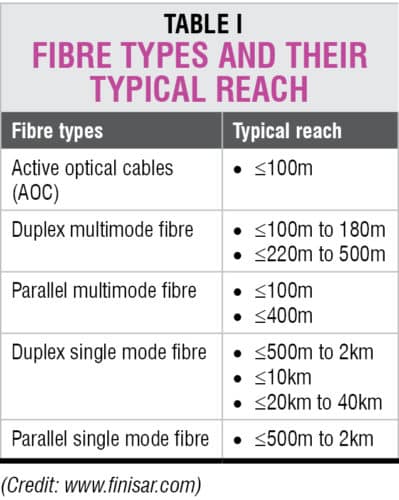
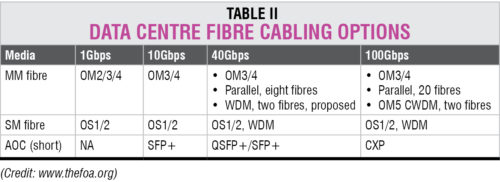
Role of optical-fibre for data centres
Establishing high-speed network connections is now a function of the availability of physical media like fibre rather than being dependent on more expensive proprietary network equipment. It is now almost as easy to set up a 100Gbps or faster optical connection across hundreds to a thousand kilometres or more as it is for a short few hundred metres between racks at an interconnect point.
With availability of fibre, data centres are no longer restricted to one or two centralised locations. Instead, these can be at any place that has a fibre connection, with information collected, stored and transferred to where it is needed for business processes or regulatory requirements.
The role of cable manufacturers is to adapt to new customer requirements in terms of density, bandwidth, latency and form factors. Cables with larger fibre counts, with small primary buffer diameters, will find more applications. Use of stranded ribbon cables allows operators faster installations. Cables with more accurate fibre length not only save money but also facilitate installation. Need for equalised optical length cables is already present for some fintech customers, whether that is standards lead or a government or financial authority requirement.
A fibre-optic cable delivers the fastest and cleanest connections. It is more reliable and future-proof than copper. It can save money in the long term, and only a basic understanding is required for a successful deployment.
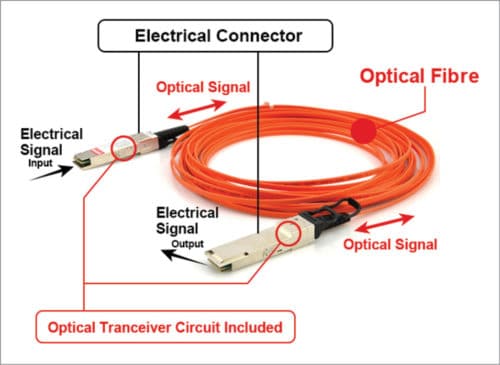
Multi-mode fibre versus single-mode fibre
Multi-mode (MM) fibre can work over a range of 100m depending on the type of fibre chosen, but it is limited on power budget, which means the cable plant must be a low loss. It is commonly used for inter-office deployments and performs better in short distances. Due to its larger inner core, it can be lit by cheaper, less complex equipment than a single-mode (SM) fibre. It has been widely used for up to 10G, but beyond 10G, cost and cabling bulk become a challenge. So, it utilises parallel optics with 10G channels to build higher speeds.
MM runs out of bandwidth at 10G, so parallel optics with separate 10G channels are used at 40G and 100G. Four 10G channels for 40G and ten 10G channels for 100G are used to support equipment. MM links at 10G are also power-limited due to the limited modal bandwidth of MM fibre.
SM fibre is most commonly used by Internet service providers (ISPs) and telephone companies because of its ability to span long distances. The equipment needed to work with SM fibre is more expensive due to the small central core of the fibre-optic cable. It requires a bright and powerful light source to use the cable.
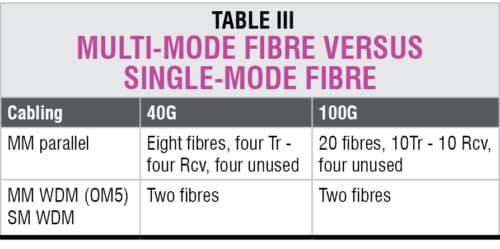
SM-distributed feedback lasers are inherently more expensive than MM vertical-cavity-surface-emitting lasers (VCSEL), and this cost differential continues indefinitely. The higher cost of SM transceivers translates to a higher total channel cost in spite of the fact that SM fibre is cheaper than MM fibre. But VCSEL sources require many more fibres, and that can offset the higher cost of SM wavelength division multiplexing (WDM) transceivers. SM fibre at 100G is especially advanced, using 4x25G channels over each fibre, making it much less complex in the cable plant.
Due to its unlimited bandwidth and distance, SM fibre is becoming more popular in data centres. Connections to the Internet coming in from the outside world will be on SM fibre, as it allows more flexibility in the number of interconnections. SM transceivers are more expensive but cabling is much cheaper and easier to install, upgrade and manage. SM fibre has advantages of testing time and cost, probably enough to balance out the higher cost of transceivers.
Optimised fibre-optics solutions
Choice of fibre usually depends on data centre design choices. Laser-optimised 50/125µm OM3/OM4 MM fibre channel is the primary method to reliably link servers to external data storage devices in enterprise data centres. Bend-insensitive fibre performs better in cramped cable trays and racks. Even inside the servers, increasing speed and reducing power has led to the need for optical fibre interconnect development.
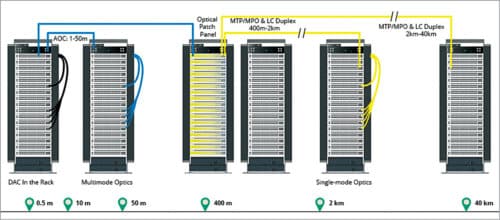
The idea developed by Cisco and Finisar is making MM fibre a possibility for up to 400G, or at least 100G on only two fibres. It uses 840nm – 940nm wavelength range with 30nm spacing WDM, with VCSELs on an upgraded OM4 fibre, now standardised as OM5. Cisco is already using this technology and, while it has been standardised, it is not widely available commercially.
Optical-fibre cabling will be the only network connectivity capable of supporting data rates of 50Gbps and beyond in typical network applications. This can be demonstrated by referencing state-of-the-art 50Gbps network switches. These new high-speed switches typically contain a 50Gbps application specific integrated circuit (ASIC) designed to support 256Gbps – 50Gbps switch ports. For these large port counts, it is advantageous to aggregate 8Gbps – 50Gbps ASIC I/O ports to produce 1Gbps – 400Gbps optical switch ports. Aggregation reduces the number of switch ports from 256Gbps – 50Gbps ports to 32Gbps – 400Gbps ports in a 1RU form factor. These high-speed high-port-density network switches have significant consequences on network connectivity.
As the need for bandwidth increased, the industry began moving towards networks and cabling with higher fibre densities. Because of the increase in the number of fibres used with parallel optics, an efficient, high-density interconnect was needed.
To accommodate the high volume of connectors within ever-tighter space constraints, installers and designers created a multi-fibre push-on (MPO) connector. The MPO format dramatically reduced the amount of time, effort and space required to install and deploy network technologies, particularly in parallel optic applications. Highly-adaptable and flexible, MPO connectors have continued to evolve to meet the emerging needs of installers, data centres and organisations that rely on them.
Future options
Unlike the parallel 10G channels used with MM fibre, SM uses WDM to transmit multiple channels over one fibre at different wavelengths. Thus, 40G uses four 10G wavelengths and 100G is achieved using four 25G wavelengths.
Parallel optics is the preferred technology due to cost and safety factors. Although the cost of cabling is lower for SM WDM, cost benefits are not realised until the channel reach exceeds 100m, which exceeds the maximum reach for the majority of MM fibre applications. Transceivers emit high optical power levels to compensate for high insertion loss of WDM devices, which approach eye safety limits.
Ongoing development for high-performance servers and storage technologies drives the need for increased fibre channel data rates to reliably link these devices. This will maximise operating efficiencies and enable low-cost value propositions. The fibre channel’s deterministic data delivery, low latency and proven reliability have made it the leading transport technology for linking servers to external data storage.





